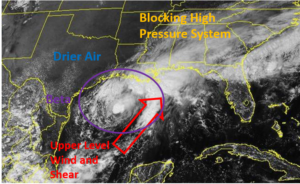Former Hurricane Teddy brought wind and rain to Nova Scotia on Wednesday. At 11:00 a.m. EDT on Wednesday the center of Tropical Storm Teddy was located at latitude 46.0°N and longitude 61.3°W which put it about 150 miles (240 km) southwest of Port aux Basques, Newfoundland. Teddy was moving toward the north-northeast at 26 m.p.h. (43 km/h). The maximum sustained wind speed was 60 m.p.h. (95 km/h) and there were wind gusts to 75 m.p.h. (120 km/h). The minimum surface pressure was 967 mb.
A Tropical Storm Warning was in effect for the portion of the south coast of Nova Scotia from Ecum Secum to Meat Cove. A Tropical Storm Warning was also in effect for the portion of the coast from Port aux Basques to Francois, Newfoundland. Tropical Storm Watches were in effect for the portion of the coast from Meat Cove to Brule, Nova Scotia, for the Magdalen Islands and for Prince Edward Island.
The center of former Hurricane Teddy made landfall near Ecum Secum, Nova Scotia on Wednesday morning. The structure of Teddy made a transition from one typical of a tropical cyclone to one more like an extratropical cyclone as it approached the coast of Nova Scotia. The area of stronger winds expanded. Winds to tropical storm force extended out 200 miles (320 km) from the center of Teddy. The heaviest rain fell over eastern Nova Scotia. The large circulation around Teddy was producing large waves which caused water level rises and beach erosion as far away as the East Coast of the U.S.
An upper level trough over eastern North America will steer Teddy quickly toward northeast during the rest of today. On its anticipated track Tropical Storm Teddy will bring gusty winds and heavy rain to parts of southwestern Newfoundland during the next few hours.
Elswhere, former Tropical Storm Beta was dropping heavy rain over parts of Louisiana. At 11:00 a.m. EDT on Wednesday the center of Tropical Depression Beta was located at latitude 30.2°N and longitude 94.2°W which put it about 60 miles (95 km) west of lake Charles, Louisiana. Beta was moving toward the east-northeast at 9 m.p.h. (15 km/h). The maximum sustained wind speed was 30 m.p.h. (50 km/h) and there were wind gusts to 40 m.p.h. (65 km/h_. The minimum surface pressure was 1007 mb.
Tropical Depression Beta dropped heavy rain over southeastern Texas on Tuesday. There were numerous reports of flooding around Houston. Beta was moving over western Louisiana on Wednesday morning and light to moderate rain was falling over many parts of the state. Flash Flood Watches were in effect for much of Louisiana and western Mississippi. Beta will move slowly toward the northeast during the next 48 hours. Moderate to heavy rain could spread over Mississippi, Tennessee, northern Alabama, western North Carolina and western Virginia.

